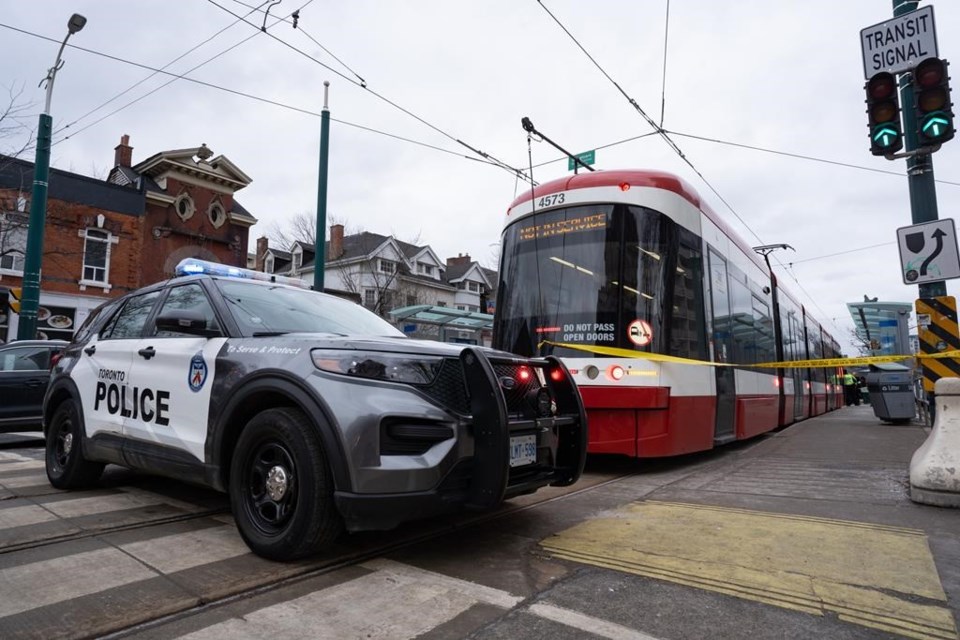TORONTO — Commuters expressed mixed reactions on Friday as Toronto police boosted their presence on city transit in the wake of recent violence.
Police announced a day earlier that more than 80 officers would be at Toronto Transit Commission locations to reduce victimization, prevent crimes of opportunity and enhance public safety.
That came after a series of violent cases on the TTC, including stabbings, BB gun shootings and an alleged swarming.
Damira Pan, a transit user, said she has witnessed violence on transit in the past and having extra officers at subway stations made her feel safer.
"It is a good idea," she said after getting off a train at a downtown subway station. "I am always looking out for officers in case I am concerned about my safety."
Pan said the presence of police is especially needed during rush hours, when subways, buses and streetcars can get particularly crowded.
Seungbin Yoo, another commuter, said a visible police presence on transit could prevent violence, including potential hate crimes.
He said he has been feeling unsafe using transit since the COVID-19 pandemic began because of his Asian features and the anti-Asian sentiment that surfaced around the pandemic.
"I feel very unsafe to use especially the streetcars at nights," he said.
But not everyone welcomed the boost in police on transit.
Jaime Wilson, a transit rider, said having more police in the system doesn't help address potential underlying causes of violence, including homelessness and mental health issues.
"I don't think it is the solution," she said. "The solution is housing, mental health resources, addiction resources, warm spaces."
Wilson said despite the recent violence that's come under the spotlight, she thinks the city's transit system is generally safe.
"I don't think having police presence is necessary. They are not going to be everywhere, it costs a lot of money, and I don't think people are satisfied with that solution," she said.
The Amalgamated Transit Union Local 113, which represents Toronto transit employees, also said the underlying causes of violence needed to be addressed.
"ATU Local 113 calls on all levels of government to work with the TTC at tackling the root causes including housing affordability and mental health as part of the broader issue of safety on public transit," it wrote in a statement Friday.
"Without addressing the problem at its core, we won't have a transit system free from violence."
Some observers worried about the effects the increased police presence could have on vulnerable populations.
Diana Chan McNally, a harm reduction case manager at the non-profit All Saints Church, worried that messaging conflating violence on the TTC with homeless individuals taking shelter on transit could make unhoused individuals a target for police. Homeless people already account for many police interactions, she said.
"(Unhoused individuals) automatically see police as unfriendly, as people who are going to escalate a situation, as people who are going to criminalize them oftentimes for doing the most basic things to survive in this hostile environment," she said.
Chan McNally said she's afraid the increased police presence on transit will lead to more deaths like the case of 18-year-old Sammy Yatim, who was shot by police officer James Forcillo while standing alone holding a small knife on an empty streetcar in July 2013.
"People who are experiencing crisis are not criminals, they need support," she said.
Gary Kinsman, spokesman for the No Pride in Policing coalition, argued the expansion of police on transit could give officers leeway to "intimidate, scare, threaten and perhaps do violence to Black, Indigenous, racialized and homeless people."
In June, former interim Toronto police chief James Ramer apologized to the city's Black residents as it released race-based data showing Black people faced a disproportionate amount of police enforcement and were more likely to have an officer point a gun at them than white people.
In a Racial Equity Impact Assessment submitted to the TTC board in April 2021, researchers found that Black and Indigenous people were overrepresented in TTC enforcement incidents, charges and cautions between 2008 and 2018. The TTC then introduced anti-bias training for transit constables and fare inspectors focused on Black and Indigenous transit users.
Toronto Mayor John Tory has said increased police on the TTC is one part of addressing safety issues and the city will continue investing in mental health and addictions treatment and anti-violence programs.
Police Chief Myron Demkiw has said the increased police patrols on the TTC will be filled by off-duty officers who will be paid overtime, so on-duty officers can still respond to priority calls.
Police have said they will be using their own data, as well as information from the TTC and communities to adjust officer deployment locations and times.
Ontario Premier Doug Ford said the boost in police was a "Band-Aid solution" and went on to call for the city to hire more police officers.
"We need full-time police officers because right now … we’re really relying on the existing police officers to come in and sign up for the callbacks," he said. "It’s not a full team there, that’s what we need."
Earlier this month, Tory announced a proposed $48.3 million increase to Toronto's police budget which would in part go toward the addition of about 200 officers, as well as programming aimed at addressing youth violence.
Chief Demkiw has said the increase would address requests for the force to improve its lagging response times, boost its presence in the downtown core and build on its neighbourhood policing program.
This report by The Canadian Press was first published Jan. 27, 2023.
———
This story was produced with the financial assistance of the Meta and Canadian Press News Fellowship.
Sharif Hassan and Tyler Griffin, The Canadian Press

